The Dazu Rock Carvings Scenic Area is located in Dazu District, Chongqing, China. It is a World Cultural Heritage site and a national 5A-level tourist attraction. Centered on the five mountain grottoes of Baoding Mountain, Beishan, Nanshan, Shimenshan, and Shizhuanshan, the scenic area is an outstanding representative of late Chinese grotto art. It integrates Buddhist, Taoist, and Confucian "three teachings" statues, demonstrating the pinnacle achievements of Song Dynasty stone carving art.
The scenic area preserves more than 50,000 stone carvings and over 100,000 characters of inscriptions. The carving began in the first year of Yonghui in the Tang Dynasty (650 AD) and went through the late Tang, Five Dynasties, Northern Song, flourished in the Southern Song, and continued to the Ming and Qing dynasties, spanning more than 1,300 years. Among them, the core scenic area of Baoding Mountain Rock Carvings covers an area of about 1,100 mu. The Beishan Rock Carvings, carved in the first year of Jingfu of Emperor Zhaozong of the Tang Dynasty (892 AD), currently have more than 5,000 statues.
Historical Culture
The excavation of Dazu Rock Carvings is closely related to the social and economic development of the Bashu region during the Tang and Song dynasties. After the Anshi Rebellion in the Tang Dynasty, the population of the Central Plains moved south, making Dazu an important cultural center, and Buddhist stone carvings began to emerge. During the Five Dynasties, with the support of local regimes, the scale of grotto statues expanded, and the content gradually integrated the ideas of Confucianism, Buddhism, and Taoism.
The Song Dynasty was the heyday of Dazu Rock Carvings. Represented by the Baoding Mountain Rock Carvings, they were excavated under the supervision of the eminent monk Zhao Zhifeng and took more than 70 years to complete. The statues are mainly based on esoteric Buddhist themes, combined with Confucian ethics and secular life, forming a unique style of "coexistence of humans and Buddhas". Such as the Six Paths of Reincarnation, the Parinirvana Sutra on the Great Kindness of Parents, and the Cowherd Picture, which not only have religious educational functions but also reflect the family ethics and production and living scenes of Song Dynasty society.
In 1999, Dazu Rock Carvings was listed in the World Heritage List by UNESCO, which evaluated it as "representing the highest level of world grotto art from the 9th to the 13th century" and is the last monument in the history of Chinese grotto art.
Main Attractions
Baoding Mountain Rock Carvings
Baoding Mountain Rock Carvings, located in the northeast of Dazu District, are the largest and most representative group of rock carvings in Dazu. They were carved during the Chunxi to Chunyou period of the Southern Song Dynasty (1174 - 1252 AD) and were built under the supervision of Zhao Zhifeng, taking more than 70 years to complete. The scenic area covers an area of about 2.5 square kilometers, with 19 existing groups of statues and nearly 10,000 statues, with Dafowan and Xiaofowan as the core. Dafowan is a horseshoe - shaped mountain bay about 500 meters long and 15 - 30 meters high. The statues are distributed along the rock walls of the mountain bay, with coherent content, forming a complete esoteric Buddhist system, including famous statues such as "Six Paths of Reincarnation", "Grand Treasure Pavilion", "Avatamsaka Trinity", and "Thousand - Handed Guanyin". Among them, the Thousand - Handed Guanyin statue is 7.7 meters high and 12.5 meters wide, with a total of 1,007 hands, each holding different ritual tools. It is exquisitely carved and resplendent, and is the largest and most complete Thousand - Handed Guanyin statue existing in China. Xiaofowan was a place where Zhao Zhifeng practiced, with thousands of existing statues, mostly esoteric themes, echoing with the statues in Dafowan, together forming a systematic esoteric Buddhist temple.
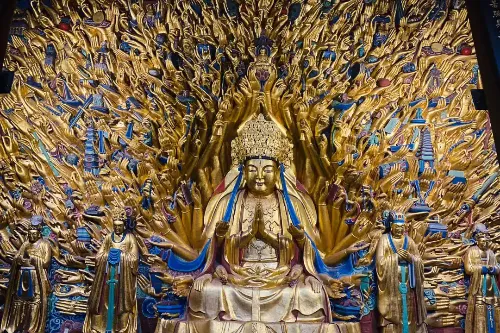
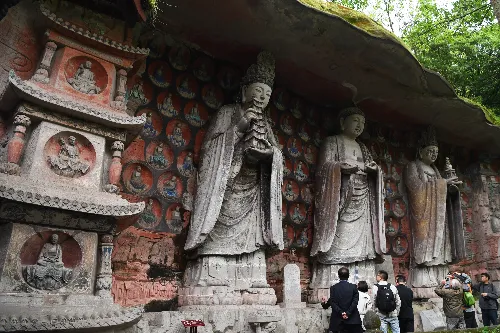
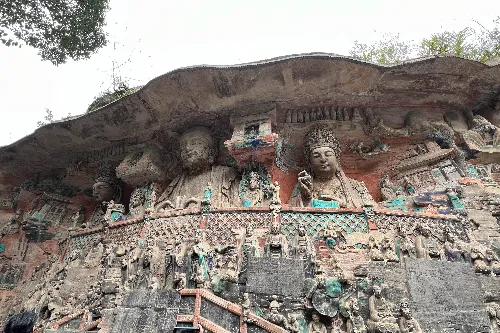
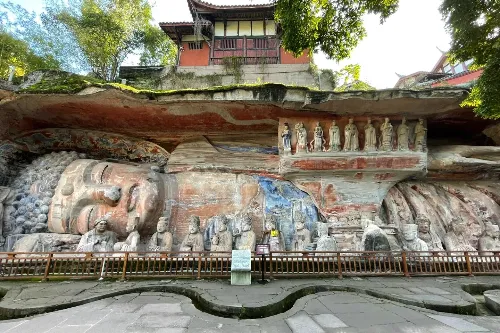
Beishan Rock Carvings
Beishan Rock Carvings are located 2 kilometers north of Dazu District. They were carved in the early Tang Dynasty and flourished in the late Tang, Five Dynasties, and Northern Song Dynasty, lasting more than 250 years. The scenic area covers an area of about 1.4 square kilometers. The statues are distributed on the west slope cliff of Beishan, which is about 300 meters long. There are 290 niches and caves, with nearly 10,000 statues, mainly Buddhist statues, and a small number of Taoist statues. Among them, the Tang Dynasty statues are dignified and magnificent, while the Song Dynasty statues are more delicate and elegant, reflecting the artistic styles of different periods. The most famous "Revolving Sutra Repository Cave" (also known as "Xinshenche Cave") has a "Wheel - turning King" carved on the central pillar, and the niches around the wall are exquisitely carved, known as "the essence of Song Dynasty stone carving art". In addition, the "Avalokitesvara with Prayer Beads" statue (commonly known as "Charming Guanyin") has a beautiful posture, a charming expression, and fluttering clothes, and is one of the iconic works of Beishan Rock Carvings.
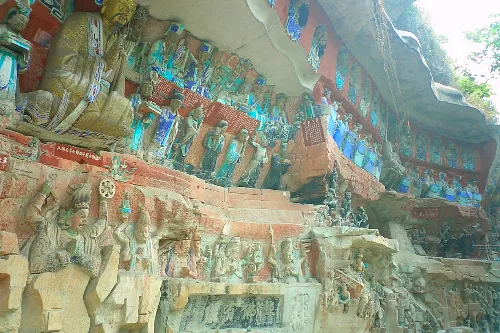
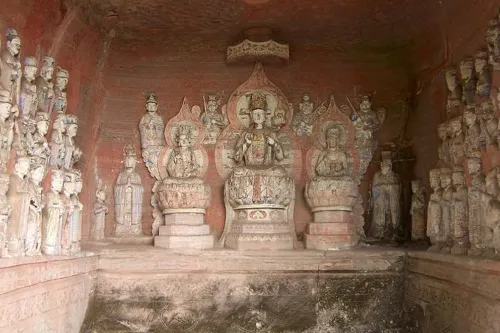
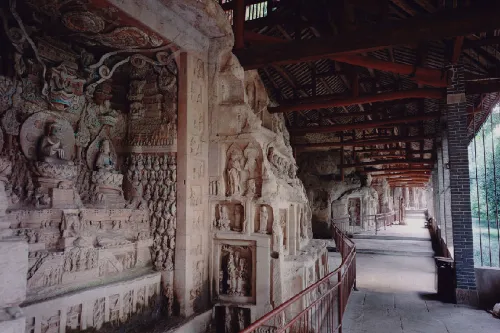
Nanshan Rock Carvings
Nanshan Rock Carvings, mainly Taoist statues, were carved during the Southern Song Dynasty, with 15 existing niches. Among them, the "Sanqing Ancient Cave" is one of the largest and best - preserved caves in Chinese Taoist stone carvings. There are 42 statues of the highest Taoist gods "Sanqing" and other gods carved in the cave, showing the artistic characteristics of Song Dynasty Taoist stone carvings.

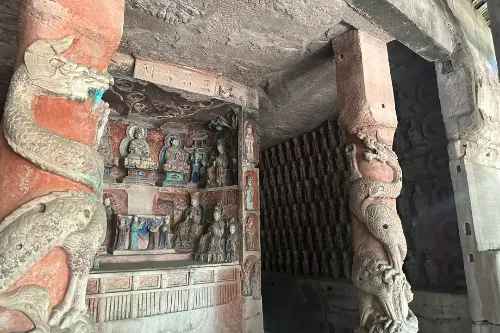
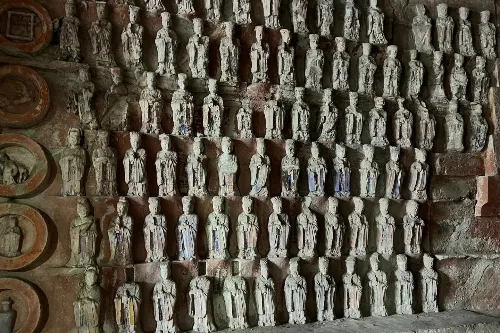
Shizhuanshan Rock Carvings
Shizhuanshan Rock Carvings are located 25 kilometers southwest of Dazu District. They were carved during the Northern Song Dynasty and are a typical representative of the "integration of three teachings" in Dazu Rock Carvings. The scenic area covers an area of about 1.2 square kilometers, with 10 existing niches and nearly 300 statues. The themes of the statues cover Buddhism, Taoism, and Confucianism, such as "Confucius and His Ten Disciples", "Manjusri and Samantabhadra", and "Statue of Laojun". The coexistence of the three teachings' statues on the mountain reflects the social trend of "integration of three teachings" in the Song Dynasty. Among them, the "Confucius Niche" carved with the images of Confucius and his ten disciples is a rare Confucian statue group in Chinese grottoes, with important historical and cultural value.
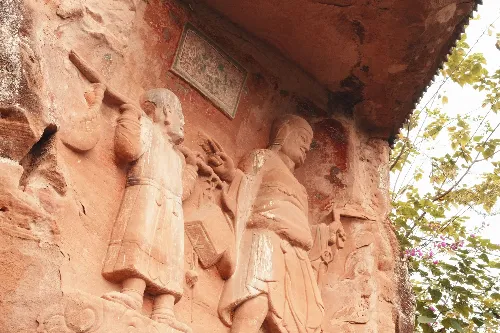

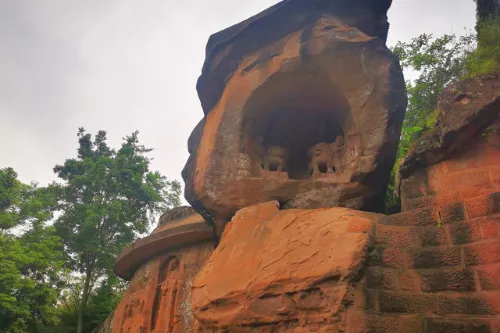
Shimenshan Rock Carvings
Shimenshan Rock Carvings are located 21 kilometers southeast of Dazu District. They were carved from the Northern Song Dynasty to the Southern Song Dynasty, mainly Taoist statues, and also integrate Buddhist statues. The scenic area covers an area of about 1.8 square kilometers, with 16 existing niches and nearly 1,000 statues. The statues are distributed on two cliff walls: the left cliff has mostly Taoist statues, and the right cliff has mostly Buddhist statues. Among the Taoist statues, the "Jade Emperor Niche" and "Three Emperors Niche" are exquisitely carved and magnificent; among the Buddhist statues, the "Water - Moon Guanyin" and "Medicine Buddha" are elegantly shaped and exquisitely crafted. Shimenshan Rock Carvings are important relics for studying the relationship between Taoism and Buddhism and carving art in the Song Dynasty.
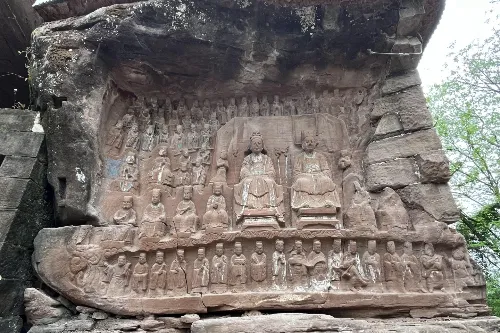
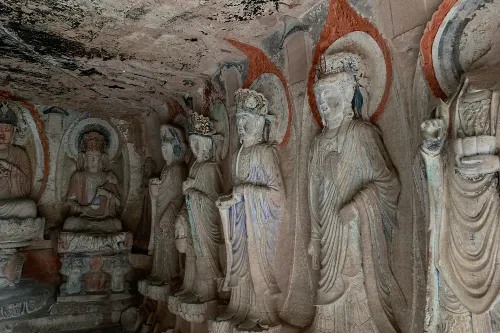
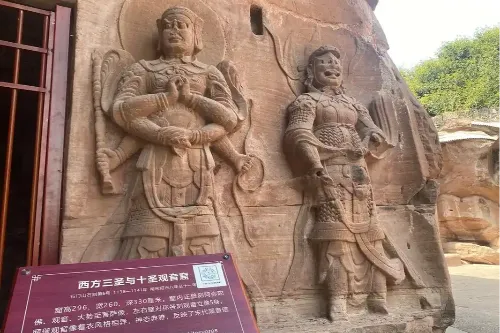
Tour Routes
Classic one - day tour route:
Morning: Baoding Mountain Rock Carvings (visit for about 3 hours, focusing on the statues in Dafowan and Xiaofowan);
Noon: Have meals in the scenic area or Dazu urban area;
Afternoon: Beishan Rock Carvings (visit for about 2 hours, including the Revolving Sutra Repository Cave and the niche of the Amitabha Sutra transformation);
Evening: Return to the urban area.
In - depth tour route (2 - 3 days):
Day 1: Baoding Mountain Rock Carvings + Nanshan Rock Carvings;
Day 2: Beishan Rock Carvings + Shimenshan Rock Carvings + Shizhuanshan Rock Carvings;
Day 3: Dazu Rock Carvings Museum (to learn about the history and culture of rock carvings) + surrounding rural tourism (such as Lotus Villa).
Travel Suggestions
- It is recommended to hire a professional guide (the guide fee for Baoding Mountain Rock Carvings is about 100 yuan) or use the scenic area's intelligent audio guide equipment to learn about the cultural stories behind the rock carvings.
- Take sun protection and heatstroke prevention measures in summer, and keep warm in winter. There is a lot of walking in the scenic area, so it is advisable to wear comfortable sports shoes.
- Tourists who want an in-depth visit can make an appointment in advance to visit remote grottoes such as Shimenshan and Shizhuanshan to experience the unique charm of these less-visited rock carvings.
- When tasting local cuisine, you can go to the "Hongsheng Square" food street in Dazu urban area to enjoy authentic local dishes and snacks.
- The recommended visiting duration is 1-2 days. The core attractions (Baoding Mountain and Beishan) can be visited in one day. If you want to have an in-depth experience of the "Five Mountains" rock carvings, you can arrange 2 days.
- The best travel seasons are spring and autumn (March-May, September-November), when the climate is pleasant with less precipitation, making it suitable for outdoor activities. In summer, pay attention to heatstroke prevention, and in winter, it is relatively cold, so keep warm.
- You can combine other attractions in Dazu District, such as the Dazu Rock Carvings Museum and Lotus Villa, to enrich your itinerary.
Matters Needing Attention
- It is strictly forbidden to touch or climb the rock carvings in the scenic area, and the use of flash when taking photos is prohibited.
- The Baoding Mountain Rock Carvings scenic area is large, so it is recommended to plan the route in advance to avoid missing core attractions.
- Shimenshan and Shizhuanshan Rock Carvings are located in rural areas with inconvenient transportation. It is recommended to drive by yourself or hire a car to get there.
- When purchasing tickets, pay attention to distinguishing between peak season and off-season prices. Preferential documents must be carried with you and presented for inspection.
- It is strictly forbidden to carve on the rock walls. Please take good care of cultural relics and abide by the scenic area regulations.
- Keep quiet during the visit, respect religious beliefs, and do not make noise or behave inappropriately in religious sites.
- The ultraviolet rays are strong in summer, so take sun protection measures such as wearing a hat and applying sunscreen. There are many trees in the scenic area, so beware of mosquito bites.
- There are rest areas and restrooms in the scenic area. You can arrange your rest time reasonably to avoid excessive fatigue.
Transportation
- Self-driving: From Chongqing urban area, take the Yurong Expressway and Tongrong Expressway to Dazhu East Exit, with a driving time of about 1.5 hours; from Chengdu urban area, take the Chenganyu Expressway to Dazhu West Exit, with a driving time of about 2.5 hours.
- High-speed rail: Take the Chengdu-Chongqing High-speed Rail from Chongqing West Railway Station to Dazhu South Station. After getting off, you can transfer to the scenic area direct bus (about one bus every 30 minutes, ticket price 15 yuan) or take a taxi (about 30 yuan) to reach Baoding Mountain Rock Carvings directly.
- Long-distance bus: There are buses directly to Dazu District from Chongqing Caiyuanba and Chenjiaping Bus Stations. After arriving, transfer to Bus No. 205 at Dazu Bus Station to Baoding Mountain Rock Carvings, or take a taxi (about 20 yuan).
Opening Hours
Baoding Mountain Rock Carvings: 09:00-18:00
Beishan Rock Carvings: 09:00-18:00
Beishan Rock Carvings (night tour): 19:30-23:00
Nanshan, Shimenshan and Shizhuanshan Rock Carvings: 09:00-17:30
The opening hours of the scenic area may be adjusted according to seasonal changes. Please obtain the latest opening hours through the official WeChat public account or the scenic area ticket office.
Tickets
Baoding Mountain Rock Carvings (including Shengshou Temple): peak season full price ticket 115 yuan, half price ticket 55 yuan; off season full price ticket 100 yuan, half price ticket 55 yuan
Beishan Rock Carvings: peak season full price ticket 70 yuan, half price ticket 35 yuan; off season full price ticket 50 yuan, half price ticket 25 yuan
Combined ticket (Baoding Mountain + Beishan): peak season full price ticket 140 yuan, half price ticket 70 yuan; off season full price ticket 120 yuan, half price ticket 60 yuan
Nanshan Rock Carvings: full price ticket 35 yuan, half price ticket 15 yuan
Shimenshan Rock Carvings: full price ticket 35 yuan, half price ticket 15 yuan
Shizhuanshan Rock Carvings: full price ticket 35 yuan, half price ticket 15 yuan
You can search for the official WeChat public account "大足石刻" to get the latest updates or buy tickets online.
Online Booking
Click here to jump to the Trip.com ticketing platform for ticket purchase.


